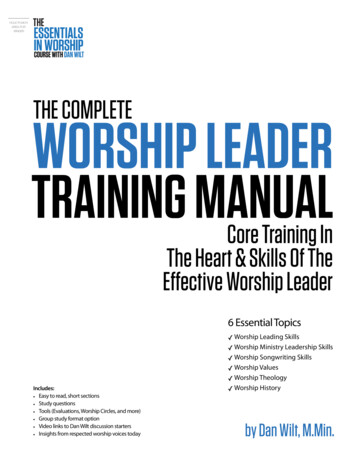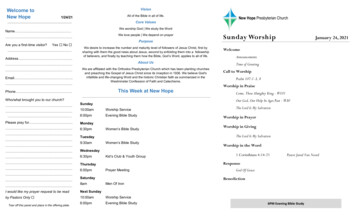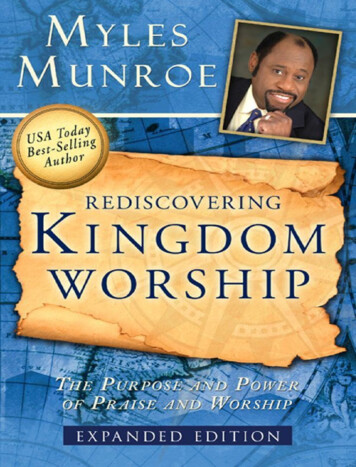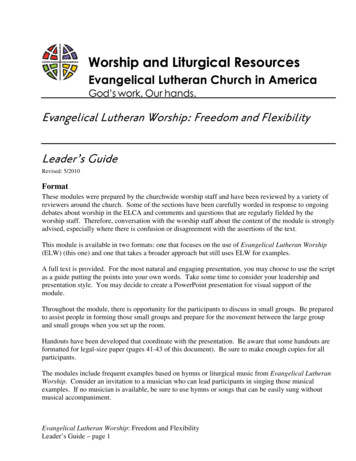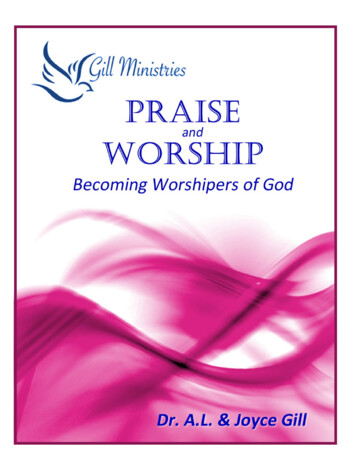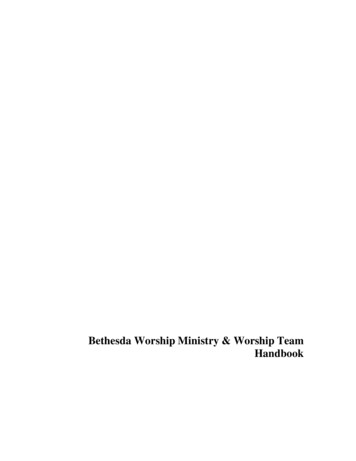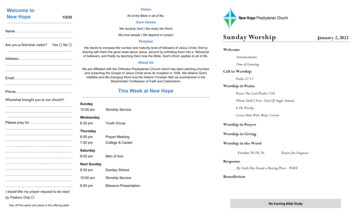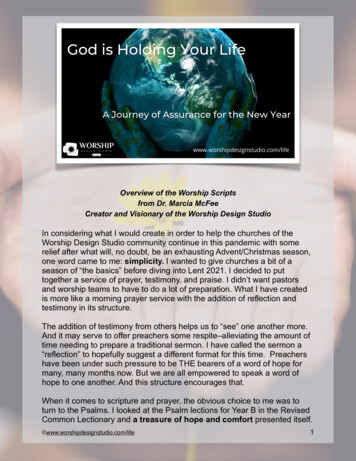
Transcription
Overview of the Worship Scriptsfrom Dr. Marcia McFeeCreator and Visionary of the Worship Design StudioIn considering what I would create in order to help the churches of theWorship Design Studio community continue in this pandemic with somerelief after what will, no doubt, be an exhausting Advent/Christmas season,one word came to me: simplicity. I wanted to give churches a bit of aseason of “the basics” before diving into Lent 2021. I decided to puttogether a service of prayer, testimony, and praise. I didn’t want pastorsand worship teams to have to do a lot of preparation. What I have createdis more like a morning prayer service with the addition of reflection andtestimony in its structure.The addition of testimony from others helps us to “see” one another more.And it may serve to offer preachers some respite–alleviating the amount oftime needing to prepare a traditional sermon. I have called the sermon a“reflection” to hopefully suggest a different format for this time. Preachershave been under such pressure to be THE bearers of a word of hope formany, many months now. But we are all empowered to speak a word ofhope to one another. And this structure encourages that.When it comes to scripture and prayer, the obvious choice to me was toturn to the Psalms. I looked at the Psalm lections for Year B in the RevisedCommon Lectionary and a treasure of hope and comfort presented itself. www.worshipdesignstudio.com/life1
And when I think about artists who know psalmody, my first thought goes toRichard Bruxvoort Colligan, a Lutheran composer-theologian-psalmistwhose music helps us enter into the heart of each Psalm. And so this dearfriend agreed to write several new compositions for this series–songs thatinvite us to the essence of each reading. As I have prepared images for hisofferings, I have been steeped in the praise, lament, petition, andassurance of the ancient songs of our spiritual ancestors.Another inspiration came from dear friends of the Order of St. Luke, areligious order rooted in the Wesleyan tradition dedicated to sacramentaland liturgical scholarship, education, and practice. Their 2020 publication ofA Lukan Psalter according to the usage of The Order of Saint Luke is thesource of the translation of the Psalms that I am recommending and use inthe scripts. It utilizes primarily The Inclusive Bible but also someadaptations of their own to provide the most poetic and lyrical versions Iknow. If you want to learn an ancient practice still in use today, this volumeincludes instructions and notations for chanting some of the Psalms.Included in this series is an interview about this with one of the editors,Rev. Dr. Dwight Vogel.This overview will give you a sense of what’s included each week in theorder of worship. The package also includes ideas for Visuals,suggestions for further study on the Psalms and a video trailer you cancustomize for use in publicity (or call it “evangelism” if you want). But alsoplease know that if you want to adapt these materials to fit your currentorder of worship, you can easily lift any of the suggested material out ofmy scripts and place it in your more familiar structure. Additionally, if asimpler order of worship is not what you want at this time, you can addmore hymnody to create the full service to which you are accustomed. Wehave not made hymn/song or anthem suggestions for this series since therecommendation is to keep the service short. You may want to start theservice with a familiar hymn or song of your choosing.The order of worship is the same each week. This goes with the concept Iteach that repetition is a good thing in ritual and a solid foundation isnecessary in order to be creative within it. Doing series can give you theopportunity to try on a slightly different order of worship or a different way ofdoing an element of the service for a season but keep it the same duringthat season, therefore offering some sense of familiarity and a rhythmthat flows. We have included a communion prayer separately from thescripts so you can insert that whenever you have communion. If you docommunion weekly, adapt by using that script as a model for how you www.worshipdesignstudio.com/life2
might edit according to the theme each week. As always, adapt thecommunion prayer to fit your tradition.The “Anchor Image” (main metaphor)for the series is cupped hands. Thisis a good anchor image thatsymbolizes (“point towards somethinglarger than itself”) a place where weare held and that can hold ourconcerns, our anxieties, and ourinsecurities. It also offers a verytangible way to pray as you will see inour suggestion for folks to create asimple bowl or box at home to addtheir prayers to during the serviceand perhaps also throughout theweek. In this way we are reminded to let go into the care of God thosethings we cannot control. Worshiping online–whether livestream or prerecorded is helped by ritual actions that keep us present and worshipful inour homes. Cupped hands also offer a wonderful prayer posture to use,inviting us to an embodied expression wherever we are.My prayers are with you in this time,friends. May this series help you, yourteam, and your congregation besustained and assured in this ongoingtime of difficulty.Peace & Passion,Dr. Marcia McFeeCreator and Visionary,Worship Design Studio www.worshipdesignstudio.com/life3
THE ORDER OF WORSHIPPreludeA mentor of mine said that “music is a social lubricant” and suggested that as oneenters a space (be it physical or virtual), there should always be music to set amood and tone for the gathering. This is especially true of online gatherings. Inthis series, I suggest that the “entrance” to the time together be a recorded loopof visuals and music that helps set a tone of calm (because calm, as well asanxiety or any other emotion, can be contagious).Welcome and AnnouncementsDo this as is your custom and then move to a sentence that will transition folksinto the “threshold moment.” The first week is a longer introduction to the wholeseries and then I have suggested something like “Let us seek to simplify thismoment, slow down for a time. Let us worship, leaning on prayer, reflection andsharing with one another” for subsequent weeks.Threshold MomentThis concept of a “threshold moment” that I teach introduces people to thejourney and the theme of the day at the beginning of the service so thateverything in worship is seen through that lens. This section is one of the videopackages that I have created and includes the logo imagery at the very beginningalong with the synopsis for the week. Then one of the verses and refrain from thetheme song (“God is Holding Your Life”) is sung. The this song has three versesso I have divided them such that the first verse is sung the first two weeks, etc.and the 7th week has all three verses–the whole song for the last week of theseries. I have provided two versions of these videos: one with my voice readingthe synopsis and one without a VoiceOver so that you can edit your own voice(s)into the video.Opening Collect PrayerAfter the video, I have written a prayer for each week that is in an ancient prayerform called a “collect.” This prayer form has five parts: 1) name for God; 2) whywe call God by this name; 3) a petition asking God for something; 4) why we areasking for this “so that ”; 5) a sentence of praise. This is one of the mostmeaningful ways to teach people to write simple prayer liturgy (my seminarystudents always have fun with this). If you are holding a small group associatedwith this series, it might be fun to invite people to try their own hand at this form.Here is an example from Week 1: www.worshipdesignstudio.com/life4
Leader: Holy and Just God,You have shown us what is right and good.Open us this day to a vision of the world made all-rightso that we might follow your ways and know the peace of your reignon earth as it is in heaven.People: We praise you for your steadfast presence,holding our lives together in love.Amen.Psalm ReadingWe dive now into the Psalm for the week. The translation, as I said above, isfrom The Lukan Psalter. You may choose various ways of reading this–onevoice, several voices taking turns at line breaks, or even chanting some of them(see my interview with Dwight Vogel about this). Because the following song hasimages included, it is a good idea just to feature the reader(s) visually for thisseries.Psalm SongRichard Bruxvoort Colligan has written new songs featuring the Psalms in ourseries. These songs are preceded by an introduction from Richard himself! Thenthe song follows with imagery to help us enter visually into the “feel” or “ethos” ofthe text. The refrains to Richard’s songs are easy to catch onto so those whowant to sing along will do so easily. I am also including a version of the songvideo in the downloads that does not have Richard’s introduction so you couldpost it to your YouTube or Facebook page and encourage people to watch itthroughout the week, perhaps as a daily prayer.Reflections and TestimoniesThis is where the typical “sermon” would be in the order of worship. Hopefully bycalling it something other than “sermon,” the expectations will loosen a bit to offera break for the preacher. A short reflection by the pastor about the Psalm couldbe followed by testimony by members about how they have felt God “holdingtheir lives” in this last year and moving forward. You may choose to ask oneperson to speak (live or prerecorded) or you may make a collage of shortstatements from several people (solicit written or video testimonies to weavethroughout the series). Again, I urge you to do what is “do-able” for YOU andyour team and resources–not too complicated–just heartfelt. www.worshipdesignstudio.com/life5
Sung RepriseThe refrain of the theme song is repeated–either once at the end of theReflections and Testimonies or as a woven thread between reflections andtestimonies.“Selah” MomentThe Psalms have a repeated direction throughout–the word “Selah.” Scholars arenot sure exactly what it means. Perhaps because the Psalms were to be used inworship, we can surmise that the word indicates a pause, or an invitation for amusical instrument to be played. In this worship series, we will use thismysterious word to denote a time of settled silence and sense of being held. Youwill use an instrumental sound of some kind (chime, bell, gong, singing bowl, rainstick) to take a pause and settle in silence for a bit. The instrumental sound willindicate the end of the silence.Prayers of the PeopleEach week the beginning of the prayers of the people includes a moment ofwriting concerns on small pieces of paper and placing in a bowl or box that actsas a stand-in for cupped hands (it can have a photo or drawing of cupped handson it as we have suggested in the Visual and Media document). You can do thiswhere you are (Zoom live or pre-recorded at home or sanctuary) and your folkscan do this at home. Then the continuing prayers could be done as is familiar toyour folks. We all need the comfort of familiarity in these times. However, I havealso provided an intercessory litany of concerns if you’d like to incorporate thatinto the prayers.Sung Prayer ResponseA beautiful song by Fred Kaan, “Put Peace Into Each Other’s Hands,” has been afavorite of mine for a long time. It seemed perfectly suited to our series with itshands anchor image. David Horton, WDS Trainer-in-Training and musicianextraordinaire, has created music tracks that you can use for this song. You willneed a OneLicense streaming license to post this song in public (https://onelicense.net/how-it-works#podcast). Substitute another public domain prayersong if you do not have, or cannot get, this license.The Sung Prayer Response incorporates a Passing of the Peace by extendingcupped hands in the direction of the camera (for Zoom live), www.worshipdesignstudio.com/life6
Communion LiturgyI have written a communion liturgy for this series that draws on the idea of“Selah.” Insert this whenever your community celebrates the Eucharist. It alsofeatures a soundtrack by David with the same song as the prayer response oruse the words of the liturgy without the song woven throughout. As always, adaptmy liturgy to align with your denomination’s communion practice.BenedictionThe blessing at the end of the service is the same each week, reminding us thatwe are held and we are called to hold each other:Now go in the knowledge thatGod is holding your lifeeven as we hold each other.You are not alone.You are loved.Amen.PostludeThe postlude is at your discretion. Again, if you want to make this a fuller service,you would add another hymn/song before closing.I hope this helps you get an at-a-glance feel for the scripts!See the synopses for every worship experience in the series HEREIf you haven’t purchased the series yet (free to WDS members), click HEREIf you’d like to get access to ALL our series, check out a Worship DesignStudio subscription HERE www.worshipdesignstudio.com/life7
Worship Design Studio community continue in this pandemic with some relief after what will, no doubt, be an exhausting Advent/Christmas season, one word came to me: . ("God is Holding Your Life") is sung. The this song has three verses so I have divided them such that the first verse is sung the first two weeks, etc.


